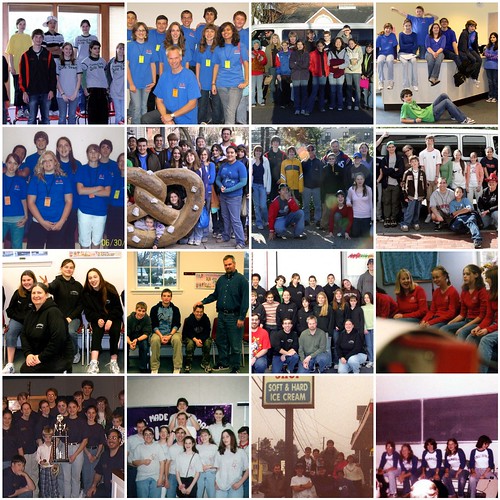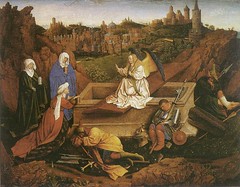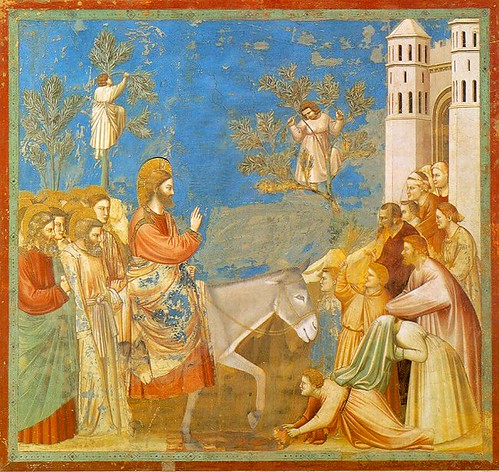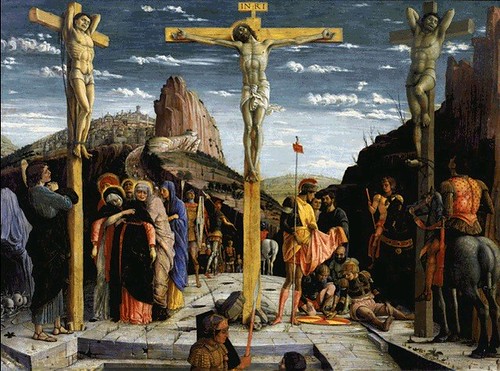
Wednesday, April 30, 2014
Tuesday, April 29, 2014
Monday, April 28, 2014
 DID YOU KNOW: How was the Bible put together?
DID YOU KNOW: How was the Bible put together?
"DID YOU KNOW?" will be a summer series where we review issues of the Bible and the Christian faith of special interest. If you have a suggestion/question that you'd like addressed in a "DID YOU KNOW?" segment, please e-mail the coaches.
How was the Bible put together? How did history decide which books were in and which ones were out?
The current list of books in the Bible - known as the "canon" - was put together in different ways for the Old Testament and New Testament. But despite what some fiction authors might like to claim, the process was not secretive or mysterious.
How was the Bible put together? How did history decide which books were in and which ones were out?
The current list of books in the Bible - known as the "canon" - was put together in different ways for the Old Testament and New Testament. But despite what some fiction authors might like to claim, the process was not secretive or mysterious.
...there was very little controversy over the canon of the Old Testament. Hebrew believers recognized God’s messengers and accepted their writings as inspired of God. While there was undeniably some debate in regards to the Old Testament canon, by A.D. 250 there was nearly universal agreement on the canon of Hebrew Scripture...
For the New Testament, the process of the recognition and collection began in the first centuries of the Christian church. Very early on, some of the New Testament books were being recognized. Paul considered Luke’s writings to be as authoritative as the Old Testament (1 Timothy 5:18; see also Deuteronomy 25:4 and Luke 10:7). Peter recognized Paul’s writings as Scripture (2 Peter 3:15-16). Some of the books of the New Testament were being circulated among the churches (Colossians 4:16; 1 Thessalonians 5:27). Clement of Rome mentioned at least eight New Testament books (A.D. 95). Ignatius of Antioch acknowledged about seven books (A.D. 115). Polycarp, a disciple of John the apostle, acknowledged 15 books (A.D. 108). Later, Irenaeus mentioned 21 books (A.D. 185). Hippolytus recognized 22 books (A.D. 170-235). The New Testament books receiving the most controversy were Hebrews, James, 2 Peter, 2 John, and 3 John...
The councils followed something similar to the following principles to determine whether a New Testament book was truly inspired by the Holy Spirit: 1) Was the author an apostle or have a close connection with an apostle? 2) Is the book being accepted by the body of Christ at large? 3) Did the book contain consistency of doctrine and orthodox teaching? 4) Did the book bear evidence of high moral and spiritual values that would reflect a work of the Holy Spirit?
Sunday, April 27, 2014
 HUMOR: Heavenly Accomodations.
HUMOR: Heavenly Accomodations.
Not mine. From here.
One Easter a priest and a taxi driver both died and went to heaven. St. Peter was at the Pearly gates waiting for them.
'Come with me,' said St. Peter to the taxi driver.
The taxi driver did as he was told and followed St Peter to a mansion. It had everything you could imagine from a bowling alley to an Olympic size pool.
'Oh my word, thank you,' said the taxi driver.
Next, St. Peter led the priest to a rough old shack with a bunk bed and a little old television set.
'Wait, I think you are a little mixed up,' said the priest. 'Shouldn't I be the one who gets the mansion? After all I was a priest, went to church every day, and preached God's word.'
'Yes, that's true.' St Peter rejoined, 'But during your Easter sermons people slept. When the taxi driver drove, everyone prayed.'
Saturday, April 26, 2014
 HOLY WEEK LEFTOVERS: Where do the symbols of Easter come from?
HOLY WEEK LEFTOVERS: Where do the symbols of Easter come from?
Holy Week raises lots of questions worth answering, which we don't always get around to discussing during Holy Week. We'll take a few days this week to look at those questions.
QUESTION 4: Easter has a lot of traditions/symbols. From where do we get the egg, bunny, etc.?
Tradition is always a tricky thing to talk about, because each culture and even sub-culture can have their own traditions. But traditions almost always go back to a real core of truth, somewhere in their past. Let's go over a few of the most common Easter traditions:
QUESTION 4: Easter has a lot of traditions/symbols. From where do we get the egg, bunny, etc.?
Tradition is always a tricky thing to talk about, because each culture and even sub-culture can have their own traditions. But traditions almost always go back to a real core of truth, somewhere in their past. Let's go over a few of the most common Easter traditions:
- Rabbits (The Easter Bunny): Easter is all about life, and rabbits have long been symbols of life due to their large families. But there is more to it when it comes to the celebration of the resurrection of Jesus Christ. The rabbit coming out of her hole is a symbol reminding us of Jesus emerging from his tomb.
- Eggs (Easter Egg Hunts/Rolls): Eggs are also symbols of life. And a chick emerging from what previously looked like a lifeless stone is a symbol reminding us (again) of Jesus emerging from the tomb. The coloring of eggs comes from old traditions which forbade the eating of eggs during Lent (as a symbol of denying oneself) but encouraged their eating at Easter as a celebration. The rolling of Easter Eggs is symbolic of the stone being rolled away from the opening of the tomb.
- Candy: There is nothing subtle about this. Candy is a sign of celebration and a symbol of the sweetness of life. Candy makers have, of course, embraced this as a chance to sell every kind of sugary snack imaginable which cover the other symbols of Easter.
- Parades: While modern Easter parades don't look much different from Christmas or New Years (or NCAA champion) parades, ancient Easter parades were quite different. They were made up of new converts to Christianity and people who were newly baptized, wearing white to proclaim to the world that they had been forgiven of their sins.
- Lilies: Easter lilies are always purest white, reminding us of the purity of our new life as forgiven people, saved by the blood of Jesus Christ.
- Sunrise Services: Well, this one is no mystery. The women went to the tomb in the early morning, and that is when they discovered - to their great confusion and soon to their great joy - that his corpse was not there. Jesus was alive!
- New Clothes for Easter: The buying and wearing of new clothes at Easter is not just about "looking your best for God". It is also a symbol of the new life Christ brought us with his death and resurrection, clothing us in his own righteousness.
Labels:
DIDYOUKNOW,
easter,
he is risen,
holy week,
leftovers,
symbols,
traditions
Friday, April 25, 2014
Thursday, April 24, 2014
 HOLY WEEK LEFTOVERS: Why do we call Resurrection Sunday by the name "Easter"?
HOLY WEEK LEFTOVERS: Why do we call Resurrection Sunday by the name "Easter"?
Holy Week raises lots of questions worth answering, which we don't always get around to discussing during Holy Week. We'll take a few days this week to look at those questions.
QUESTION 3: Where does the name "Easter" come from?
This is a big question and hard to answer, because language changes so much over time. There are two primary theories for the origin of the word "Easter".
Pagan Origins: Eastre (or Eostre) was a goddess of the Saxon peoples of Northern Europe, associated with Springtime and especially rabbits. (It is believed this is where the idea of the Easter Bunny may have come from, although the fact that rabbits emerge from a hole in the ground also makes them a natural symbol for Jesus emerging from the tomb.) This theory is that a feast to Eastre was held in the Springtime. Christian missionaries did not want to deny their converts a chance to celebrate, so instead of banning the old celebration they replaced the former significance with a celebration of the resurrection of Jesus Christ. The practice of "redeeming" pagan holidays with new Christian significance was quite common in the old Roman Empire.
German Origins: The german word for "resurrection" is "auferstehung"(say it fast, you can get a sense of how it could have morphed into "easter" over centuries of time). Under this theory, the word was first used by early German Christians to refer to the time of Passover, reflecting the fact that Resurrection Sunday would historically be the Sunday after Passover. Over time, the word's use was expanded and expanded as people began to not only note the day on their calendars, but make a celebration out of it. Finally, the word "Easter" eclipsed Passover in the mind of Christian Europe (much of which had never known a Jewish person or read a Bible, so the significance of the old Hebrew holiday was lost). This theory is supported by the fact that Easter first appears as a word in German writings, rather than Saxon ones.
QUESTION 3: Where does the name "Easter" come from?
This is a big question and hard to answer, because language changes so much over time. There are two primary theories for the origin of the word "Easter".
Pagan Origins: Eastre (or Eostre) was a goddess of the Saxon peoples of Northern Europe, associated with Springtime and especially rabbits. (It is believed this is where the idea of the Easter Bunny may have come from, although the fact that rabbits emerge from a hole in the ground also makes them a natural symbol for Jesus emerging from the tomb.) This theory is that a feast to Eastre was held in the Springtime. Christian missionaries did not want to deny their converts a chance to celebrate, so instead of banning the old celebration they replaced the former significance with a celebration of the resurrection of Jesus Christ. The practice of "redeeming" pagan holidays with new Christian significance was quite common in the old Roman Empire.
German Origins: The german word for "resurrection" is "auferstehung"(say it fast, you can get a sense of how it could have morphed into "easter" over centuries of time). Under this theory, the word was first used by early German Christians to refer to the time of Passover, reflecting the fact that Resurrection Sunday would historically be the Sunday after Passover. Over time, the word's use was expanded and expanded as people began to not only note the day on their calendars, but make a celebration out of it. Finally, the word "Easter" eclipsed Passover in the mind of Christian Europe (much of which had never known a Jewish person or read a Bible, so the significance of the old Hebrew holiday was lost). This theory is supported by the fact that Easter first appears as a word in German writings, rather than Saxon ones.
Labels:
auferstehung,
DIDYOUKNOW,
easter,
eastre,
eostre,
germany,
he is risen,
holy week,
leftovers
Wednesday, April 23, 2014
 HOLY WEEK LEFTOVERS: Was Jesus really in the tomb for 3 days?
HOLY WEEK LEFTOVERS: Was Jesus really in the tomb for 3 days?
Holy Week raises lots of questions worth answering, which we don't always get around to discussing during Holy Week. We'll take a few days this week to look at those questions.
QUESTION 2: Was Jesus really in the tomb for 3 days?
There are big questions and there are little questions, and this is one that people argue over the size of. Many ask, "If Jesus died Friday night and rose Sunday morning, how does that work out to three days?" After all, he was only in the tomb for a full day on Sunday, right?
Nope. First century Jews thought about the calendar differently than moderns do:
QUESTION 2: Was Jesus really in the tomb for 3 days?
There are big questions and there are little questions, and this is one that people argue over the size of. Many ask, "If Jesus died Friday night and rose Sunday morning, how does that work out to three days?" After all, he was only in the tomb for a full day on Sunday, right?
Nope. First century Jews thought about the calendar differently than moderns do:
- Days start at sundown on the Jewish calendar.
- People of the time didn't think in 24 hours days, where 3 days meant "exactly 72 hours". Rather, they thought in terms of day periods. For something to happen "on the third day" was always considered to mean "sometime during the third day". (72 hours later would be "on the fourth day".)
- When Jews of the time spoke about "three days and three nights", partial days were considered sufficient. In Esther 4 and 5, she fasts "for 3 days and 3 nights" but goes to the king "on the third day".
Thus, Jesus being in the tomb for three days was fulfilled by:
- Some time on Friday (Jesus died in the afternoon, before sunset)
- All day on Saturday
- Some time on Sunday (Jesus was seen by the women in the morning)
3 days, even though it was not 72 hours later.
Labels:
3,
3 days,
DIDYOUKNOW,
he is risen,
holy week,
leftovers,
three,
three days
Tuesday, April 22, 2014
Monday, April 21, 2014
 HOLY WEEK LEFTOVERS: How do we know Jesus actually rose?
HOLY WEEK LEFTOVERS: How do we know Jesus actually rose?
Holy Week raises lots of questions worth answering, which we don't always get around to discussing during Holy Week. We'll take a few days this week to look at those questions.
QUESTION 1: HOW DO WE KNOW JESUS ACTUALLY ROSE FROM THE DEAD?
Since the very day Jesus rose from the dead, people have been trying to argue it didn't happen. (The gospels actually record an attempted payoff from the Sanhedrin to the tomb guards to claim the disciples had stolen the body.) But there is plentiful evidence that Jesus died and that he rose again!
QUESTION 1: HOW DO WE KNOW JESUS ACTUALLY ROSE FROM THE DEAD?
Since the very day Jesus rose from the dead, people have been trying to argue it didn't happen. (The gospels actually record an attempted payoff from the Sanhedrin to the tomb guards to claim the disciples had stolen the body.) But there is plentiful evidence that Jesus died and that he rose again!
- Jesus Died: The Romans were experts at killing and crucifixion was one of their go-to methods for killing. The gospels even record that the guards at the cross were ready with a backup plan for anyone who hadn't died. They would break their legs, so they couldn't push themselves up to catch a breath. Instead, when they came to Jesus, they saw he was dead. But just to make sure, they thrust a spear into his side. The gospels report "blood and water" flowed, which either indicates that the blood had begun to coagulate inside the body, or that the cardiac sack around the heart had been punctured. Either way, there is now way to survive that.
- Jesus Rose: First century Jews were no fools and were used to Messiahs who didn't deliver what they promised, so it makes little sense to chalk up Jesus's appearances to superstition. Instead, the gospels report repeatedly that there were eyewitnesses to the resurrected Christ. First, he appeared to the women who came to the tomb to care for his body. Second, he appeared to Peter (and John saw the empty tomb). Third, he appeared to two unnamed disciples on the way to Emmaus. Fourth, he appeared to all of the disciples in the upper room, except Thomas. Finally, he appeared to Thomas, as well, and even showed him the scars in his hands, his feet, and his sides. And it was not just the apostles who saw him, but Paul reports in 1 Corinthians 15:6 that over 500 people saw Jesus alive (most of whom were still alive when he wrote for readers to check back with).
- Jesus Changed Lives: Finally, it is worth noting the transformation seen in the disciples after Jesus's resurrection. After the crucifixion, all accounts report they were terrified and hidden away, fearing the Romans or Sanhedrin would come for them next. They feared for their lives, and were ready to run away. But after the resurrection, suddenly they are bold and brash men with no fear for their lives. They preach, they teach, they do miracles, and they eagerly march toward martyrdom.
While we do not have a photograph of the risen Jesus to examine, all of this adds up to a lot of strong evidence that Jesus of Nazareth did indeed rise from the dead.
Labels:
DIDYOUKNOW,
he is risen,
holy week,
leftovers,
resurrection,
rise
Sunday, April 20, 2014
 HOLY WEEK: Resurrection!
HOLY WEEK: Resurrection!

1 After the Sabbath, at dawn on the first day of the week, Mary Magdalene and the other Mary went to look at the tomb.
2 There was a violent earthquake, for an angel of the Lord came down from heaven and, going to the tomb, rolled back the stone and sat on it. 3 His appearance was like lightning, and his clothes were white as snow. 4 The guards were so afraid of him that they shook and became like dead men.
5 The angel said to the women, “Do not be afraid, for I know that you are looking for Jesus, who was crucified. 6 He is not here; he has risen, just as he said. Come and see the place where he lay. 7 Then go quickly and tell his disciples: ‘He has risen from the dead and is going ahead of you into Galilee. There you will see him.’ Now I have told you.”
8 So the women hurried away from the tomb, afraid yet filled with joy, and ran to tell his disciples. 9 Suddenly Jesus met them. “Greetings,” he said. They came to him, clasped his feet and worshiped him. 10 Then Jesus said to them, “Do not be afraid. Go and tell my brothers to go to Galilee; there they will see me.”
Labels:
celebration,
easter,
holiday,
holy week,
resurrection,
sunday
Saturday, April 19, 2014
 HOLY WEEK: In the tomb
HOLY WEEK: In the tomb
It is typical to think of Saturday as an "off day" for Holy Week, but actually quite a lot was happening. Jesus was taken down from the cross and his body was wrapped in fine cloths and spices. Then Nicodemus and Joseph of Arimathea - both prominent men who had much to lose by declaring they were followers of Jesus - came forward to claim the body and place it into a rich tomb. Finally, the Sanhedrin - aware of Jesus's prophesies about resurrection - convinced Pilate to seal the tomb and guard it to protect against tampering.
Friday, April 18, 2014
 HOLY WEEK: Good Friday
HOLY WEEK: Good Friday
Good Friday is the holiest day on the Christian calendar, because it is the day Jesus died and took on all of our sins. Without his death, we would still be in our sins and under judgement for all eternity. Salvation, both Old and New Testament, is based on faith in the saving work of God thru Christ.
It was a long and difficult day for Jesus. He not only died, but went thru multiple trials before both Jewish and Gentile, both local and imperial authorities. He was offered a way out by Pilate, but the crowds chose a known murderer instead. Jesus was then tortured, and forced to carry his own cross (until he collapsed and a bystander in the crowd was drafted to carry it for him). Finally, he was nailed to the cross and after blessing nearly all those around him, died.
It is important to note how Jesus died. He was not killed, but instead scripture says he "gave up his spirit." God chose to die, because his life could not be taken from him.
It was a long and difficult day for Jesus. He not only died, but went thru multiple trials before both Jewish and Gentile, both local and imperial authorities. He was offered a way out by Pilate, but the crowds chose a known murderer instead. Jesus was then tortured, and forced to carry his own cross (until he collapsed and a bystander in the crowd was drafted to carry it for him). Finally, he was nailed to the cross and after blessing nearly all those around him, died.
It is important to note how Jesus died. He was not killed, but instead scripture says he "gave up his spirit." God chose to die, because his life could not be taken from him.
Thursday, April 17, 2014
 HOLY WEEK: Maundy Thursday
HOLY WEEK: Maundy Thursday
Maundy Thursday is the most solemn and somber of days in the Christian calendar. It marks the day that Jesus gave the Last Supper, prayed in the Garden of Gethsemane, and was betrayed by Judas.
The term "Maundy" is a reference back to the Latin "mandatum" - i.e. "command" - which comes from John 13:34-35: "A new commandment I give to you, that you love one another: just as I have loved you, you also are to love one another. By this all people will know that you are my disciples, if you have love for one another.”"
Why is this day more somber than "Good Friday" on which Jesus actually died? Because that day is made "good" by the redemption accomplished by his death on the cross. Thursday, on the other hand, is just one difficult moment for Jesus after another with no relief in sight. In light of this, it is traditional for Maundy Thursday services to end in silence, with people leaving the church without talking.
The term "Maundy" is a reference back to the Latin "mandatum" - i.e. "command" - which comes from John 13:34-35: "A new commandment I give to you, that you love one another: just as I have loved you, you also are to love one another. By this all people will know that you are my disciples, if you have love for one another.”"
Why is this day more somber than "Good Friday" on which Jesus actually died? Because that day is made "good" by the redemption accomplished by his death on the cross. Thursday, on the other hand, is just one difficult moment for Jesus after another with no relief in sight. In light of this, it is traditional for Maundy Thursday services to end in silence, with people leaving the church without talking.
Labels:
betrayal,
easter,
holy week,
judas,
last supper,
maundy,
maundy thursday
Wednesday, April 16, 2014
 HOLY WEEK: Silent Wednesday
HOLY WEEK: Silent Wednesday
Nothing is recorded in the gospels about Wednesday of Holy Week. This certainly doesn't say "nothing" happened, but scholars speculate Jesus and his disciples may have spent the day resting up for the Passover celebration in Bethany with Mary, Martha, and Lazarus.
Tuesday, April 15, 2014
 HOLY WEEK: The Olivet Discourse & Judas In Negotiations
HOLY WEEK: The Olivet Discourse & Judas In Negotiations
Tuesday of Holy Week was the day Jesus went up on the Mount of Olives to give the "Olivet Discourse" - a long sermon focussed around prophesies of the coming destruction of Jerusalem and ultimately the End Times. It is also the day that Judas negotiated the price to betray Jesus (Matthew 24:14-16)
Labels:
easter,
holy week,
judas,
judas kiss,
musical interlude,
olivet discourse,
petra,
video,
youtube
Monday, April 14, 2014
 HOLY WEEK: Clearing of the Temple
HOLY WEEK: Clearing of the Temple
On Monday of Holy Week, the major event was Jesus's cleansing of the Temple, recorded in all four gospels.
And they came to Jerusalem. And he entered the temple and began to drive out those who sold and those who bought in the temple, and he overturned the tables of the money-changers and the seats of those who sold pigeons. And he would not allow anyone to carry anything through the temple. And he was teaching them and saying to them, “Is it not written, ‘My house shall be called a house of prayer for all the nations’? But you have made it a den of robbers.” And the chief priests and the scribes heard it and were seeking a way to destroy him, for they feared him, because all the crowd was astonished at his teaching. And when evening came they went out of the city. (Mark 11:15-19)
Sunday, April 13, 2014
 HOLY WEEK: Palm Sunday
HOLY WEEK: Palm Sunday
Happy Palm Sunday! Hosanna!!!

The next day the large crowd that had come to the feast heard that Jesus was coming to Jerusalem. So they took branches of palm trees and went out to meet him, crying out, “Hosanna! Blessed is he who comes in the name of the Lord, even the King of Israel!” And Jesus found a young donkey and sat on it, just as it is written,
“Fear not, daughter of Zion;
behold, your king is coming,
sitting on a donkey's colt!”
His disciples did not understand these things at first, but when Jesus was glorified, then they remembered that these things had been written about him and had been done to him. The crowd that had been with him when he called Lazarus out of the tomb and raised him from the dead continued to bear witness. The reason why the crowd went to meet him was that they heard he had done this sign. So the Pharisees said to one another, “You see that you are gaining nothing. Look, the world has gone after him.” (John 12:12-19)

Labels:
easter,
holy week,
hosanna,
palm sunday,
palmsunday
Saturday, April 12, 2014
 Bible Knowledge Test - Answer Key
Bible Knowledge Test - Answer Key
Well, you've had the Bible Knowledge Test since Thursday, and presumably you've gone ahead and taken it. Now, here's your chance to score yourself. Click here for the answer key (or on the image below). Hope you did well!


Friday, April 11, 2014
Thursday, April 10, 2014
 Bible Knowledge Test
Bible Knowledge Test
The Bible Knowledge Test is an opportunity to show just how much you learned over the course of the year, without having to worry about anyone else competing against you. It is an invaluable opportunity to challenge yourself without anyone else looking over your shoulder.
If you missed Districts this year - or if you have a friend or family member who wants to test their knowledge - you can download a copy of this year's test here (or by clicking on the image below). We will post a copy of the answer key on Saturday.

If you missed Districts this year - or if you have a friend or family member who wants to test their knowledge - you can download a copy of this year's test here (or by clicking on the image below). We will post a copy of the answer key on Saturday.

Wednesday, April 9, 2014
 PHOTOS OF THE WEEK: Bible Quizzing Musical Chairs
PHOTOS OF THE WEEK: Bible Quizzing Musical Chairs
This past Sunday, we team joined together with the rest of the youth group to compete on James 5 and played a little Bible Quizzing Musical Chairs. Lotsa, lotsa fun.


Labels:
fun,
monroe,
musical chairs,
photo of the week,
photography,
sunday school
Tuesday, April 8, 2014
Monday, April 7, 2014
 So... What's Next?
So... What's Next?
Districts is over, practices for the year are over, so... what is next for Quiz Team in general and this blog in particular?
Well, Nationals is still coming, even though there will be no Bible Quizzing competition there. Be watching here for "spy photos" and other features when July rolls around.
In the meantime, we're going to take a month or so off from Bible Quizzing, per se, and just focus some fun. We'll be posting news related to the Bible, good music, comics, jokes, photos, and other interesting tidbits. As always, this site will be updated every day. Then, starting soon, we'll begin getting ready for the 2014-2015 season, where we'll be studying the Book of Acts.
But, for now, let's have some fun!

Well, Nationals is still coming, even though there will be no Bible Quizzing competition there. Be watching here for "spy photos" and other features when July rolls around.
In the meantime, we're going to take a month or so off from Bible Quizzing, per se, and just focus some fun. We'll be posting news related to the Bible, good music, comics, jokes, photos, and other interesting tidbits. As always, this site will be updated every day. Then, starting soon, we'll begin getting ready for the 2014-2015 season, where we'll be studying the Book of Acts.
But, for now, let's have some fun!

Sunday, April 6, 2014
Saturday, April 5, 2014
 BIBLE NEWS: The Bible in Movies
BIBLE NEWS: The Bible in Movies
The recent release of a movie loosely based on the story of Noah has brought back the question of adapting Bible stories for the big screen and whether there is a "religious market" for films. While Noah is being judged by most reviewers as "not very Biblical", there are other films out there making a bigger impact.
God’s Not Dead, about a Christian college student confronted by an atheist professor, opened last weekend with a remarkable $9.2 million in just 780 theaters, and it grossed another $9.1 million after expanding into 398 more theaters this weekend, for $22 million total. At this pace, it could easily clear $50 million as it plays into the Easter holiday weekend, a robust result for any independent film, let alone one explicitly geared toward a Christian audience.
Labels:
bible news,
entertainment,
films,
god is not dead,
hollywood,
movies,
news,
noah
Friday, April 4, 2014
Thursday, April 3, 2014
 PHOTOS: Coach Matt's Pictures from Districts
PHOTOS: Coach Matt's Pictures from Districts
If you're like me, you can't get enough of people's photos from Districts! Here now are Coach Matt's photos from the event. Click on the image below for the whole set.


Wednesday, April 2, 2014
 PHOTOS: Coach Mark's Pictures from Districts
PHOTOS: Coach Mark's Pictures from Districts
Congratulations again on your First Place Win at Midwinter! If you want relive the experience all over again, click below for all of Coach Mark's photos.


Tuesday, April 1, 2014
Subscribe to:
Posts (Atom)

 MUSICAL INTERLUDE: Jesus in My Place
MUSICAL INTERLUDE: Jesus in My Place WEEKLY COMIC: Well, that's one way to do it!
WEEKLY COMIC: Well, that's one way to do it!



_Vermeer_-_Christ_in_the_House_of_Martha_and_Mary_-_Google_Art_Project.jpg)


 One last practice for the season - JAMES 5
One last practice for the season - JAMES 5

